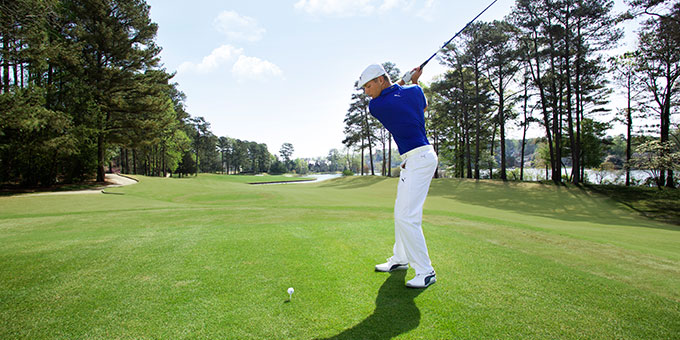Posted on February 3, 2021 in News.
USGA and R&A want to limit pros hitting distance
Almost a year to the day after the American Golf Association (USGA) and the R&A said distance is taking golf to an unsustainable path, golf's governing bodies officially announced on Tuesday that they were interested. through research on equipment linked to their performance over distances.

Bryson DeChambeau - Illustrative image - Photo: DR
The USGA and R&A want to work with manufacturers and different players to learn more about how potential changes in equipment standards and testing procedures could curb the growing trend of in-game hitting distance. elite.
"After two years of research and development of a statement of conclusions, we hoped to be able to say that we will now enter the beginning of the solution phase"USGA Executive Director Mike Davis said in an exclusive interview with Golfweek. “It was supposed to be in March 2020, and obviously, with COVID, we have rightly delayed this. "
With Tuesday's announcement of two areas of focus - the potential use of a local rule and compliance specifications for golf balls and golf clubs - the USGA is advancing its conversation on distance.
"The question is complex, and it will not be easy"said Davis, who announced he plans to retire from the USGA at the end of 2021 to focus on golf course construction. “But it's a question that has confronted golf for over a century. We are committed to solving what we believe is an issue that needs to be addressed. "
The USGA and R&A will be collecting feedback regarding the potential use of a local rule that specifies the use of clubs and balls intended to reduce striking distances. The idea is to give more flexibility to tournament organizers and route operators. Thomas Pagel, general manager of governance for the USGA, said this is not a step towards branching off or creating two sets of rules to govern golf.
“Model local rules aim to promote flexibility or options in the game, and they have been around for a long time. ", said Pagel. “We remain committed to a single set of rules. We think that's one of the great attributes of the game that binds us all together. We play with the same equipment on the same golf courses and according to the same rules. No other sport does this, and we want to keep it. "
As a second area of interest, the USGA and R&A want a review of the overall compliance specifications for clubs and balls, including specifications that directly and indirectly affect striking distances. This means that the governing bodies want to research topics such as limiting the effectiveness of balls, the size and weight of golf balls, reducing the volume and length of drivers, and reducing the size and weight of golf balls. spring effect on the faces and moment of inertia of the club heads.
The comment period for both topics ends on November 2.
The USGA and R&A also requested feedback and research on three proposed changes to equipment standards:
- Club length. As a typical local rule, reduce the maximum club length (excluding putters) from 48 inches (121,9 cm) to 46 inches (116,8 cm). This concept has been mentioned before, and the comment period on this potential change now ends on March 4. If passed a few days or weeks after that date, the Augusta National Golf Club (and any other facility) could theoretically implement a model local rule limiting club length to 46 inches during competition for all clubs except putters. The decision would be entirely at the discretion of the tournament organizers. (Hello, Bryson DeChambeau!)
- Update the method used to test golf balls. Instead of continuing to test balls by hitting them with a 10 degree test driver swung at 120 mph (193 km / h) and measuring the speed at which the balls come off the face, golf balls could be distance tested at multiple launch angles (7,5 degrees to 15 degrees) with varying amounts of reverse spin (2-200 rpm).
- Change the tolerance of the characteristic time test (CT). The spring effect in the face of a driver is limited to 239 microseconds, plus up to 18 microseconds for manufacturing tolerances. But manufacturing techniques improve every year, so what effect could reducing the tolerance to 6 microseconds have on distance?
To be clear, the USGA and R&A have not announced any changes to the rules regarding equipment. The clubs and balls that you used last weekend will be allowed to play next weekend and possibly for years to come. In fact, Davis said the USGA and the R&A have no plans to make any significant difference in recreation.
The USGA and R&A have effectively put the wheels in motion to learn more about how potential equipment changes and equipment test methods might affect distance. They want to talk to equipment manufacturers, which include amateur golfers and elite golfers, what might happen if changes are made.
Some people believe that distance has played a disproportionate role in the success of elite players, and they want equipment changes to be made quickly. This is unlikely to happen.
In 2011, the USGA, R&A, and equipment manufacturers agreed on a process for changing test methods and introducing new guidelines for equipment. Commonly known as the “Vancouver Protocols”, they define a series of events that must take place step by step before the implementation of the equipment changes. The announcement of an area of interest notice comes directly from Part 5, Section 2 of the agreement:
The USGA and the R&A continually conduct different types of research regarding golf equipment. When a research topic is likely to result in a change in equipment rules, an “area of interest” notice is published by the USGA and the R&A. Thereafter, and where appropriate, the USGA and R&A will publish any research that has been conducted and invite manufacturers, other relevant entities, and other interested parties to provide comments and participate in the research.
"This is a long-term issue, for the whole of golf"said Davis. “I think golfers need to understand that this generation of players hitting the ball further has a negative impact on the game. The cost of this is borne by all golfers. We're just trying to put golf back on the golf courses. "
To know more : https://www.randa.org/
To read our last article on the same subject :
Louise Uma Landgraf wins brilliantly at the Girls' U16 Amateur Championship
Grace Kim leads the JM Eagle LA Championship
Scottie Scheffler's coronation at the RBC Heritage








